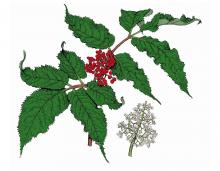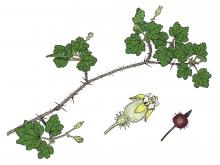Trees, Shrubs and Woody Vines
Media

Species Types
Scientific Name
Sambucus pubens
Description
Red-berried elderberry reaches 24 feet in height and does not form colonies. Its white flowers, and later, red berries, are in pyramidal clusters. In Missouri, it’s known only from Marion County.
Media

Species Types
Scientific Name
Hypericum prolificum (formerly H. spathulatum)
Description
Shrubby St. John’s-wort has shiny, somewhat leathery, opposite leaves, 2-edged twigs, and flowers with 5 bright yellow petals and many stamens. A shrub growing to 6 feet tall, it is scattered nearly statewide.
Media

Species Types
Scientific Name
Quercus spp.
Description
Oaks are the most important group of trees in Missouri, in both human and ecosystem value. They dominate most of the forests, woodlands, and savannas in the state. Learn more about our 22 species.
Media

Species Types
Scientific Name
Symphoricarpos orbiculatus
Description
Buckbrush, or coralberry, grows throughout Missouri. This familiar thicket-forming shrub bears dense clusters of pinkish-red berries that persist through most of the winter.
Media

Species Types
Scientific Name
Ribes cynosbati
Description
Prickly gooseberry occurs mostly in the eastern half of Missouri. Its spine-covered berries turn reddish purple when ripe. Despite the prickles, they are edible.
Media

Species Types
Scientific Name
Ribes missouriense
Description
Missouri gooseberry is our state’s most widespread and common gooseberry. People brave its prickly stems to collect its tart, tasty fruits to make pies, jams, and jellies.
Media

Species Types
Scientific Name
Cercis canadensis
Description
Eastern redbud is a native shrub or small tree that is distinctly ornamental in spring with small, clustered, rose-purple flowers covering the bare branches before the leaves.
Species Types
Scientific Name
Tsuga canadensis
Description
Eastern, or Canadian hemlock is usually encountered only in landscaping in Missouri. But based on one instance in Oregon County, we know it can reproduce and spread here on its own. So if you find it on a hike, it was almost certainly planted there at some point. Look around for a cistern, old home foundation, and other persisting garden plants nearby.
Media

Species Types
Scientific Name
Juniperus virginiana
Description
By far the most common native conifer in the state, eastern red cedar is useful for its aromatic, red wood and beloved for its greenery, its resinous blue “berries,” and the spicy odor it lends the outdoors.
Media

Species Types
Scientific Name
Elaeagnus umbellata
Description
Autumn olive can be found all over the state, since it was planted widely with the best of intentions. Despite its “pros,” this shrub has proven to be very invasive. It threatens native ecosystems and should not be planted.
See Also
About Trees, Shrubs and Woody Vines in Missouri
There are no sharp dividing lines between trees, shrubs, and woody vines, or even between woody and nonwoody plants. “Wood” is a type of tissue made of cellulose and lignin that many plants develop as they mature — whether they are “woody” or not. Trees are woody plants over 13 feet tall with a single trunk. Shrubs are less than 13 feet tall, with multiple stems. Vines require support or else sprawl over the ground.





















